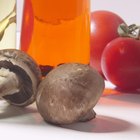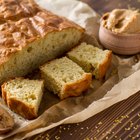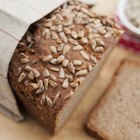
Cornbread, like many baked goods, depends on some type of fat to bind the ingredients together, and vegetable oil is usually used. Most cooking oils are liquid fats derived from plants, while olive oil is obtained by pressing ripe olives. Unlike vegetable oil, olive oil usually has a distinctive flavor, depending on how it was processed, and it's important to keep this in mind when choosing which type to use to make cornbread.
Olive Oil Basics
The array of olive oil varieties on supermarket shelves can seem overwhelming. Extra-virgin olive oil is generally considered the best because it is obtained entirely from the first pressing of the olives. Extra-virgin olive oil is generally the deepest green and has the strongest flavor, often described as fruity, of all the olive oils. Second and subsequent pressings of the olives produce pure olive oil, a lighter-colored oil with a milder flavor, while light or mild varieties are blends of pure olive oil and lesser-quality virgin oil and have a flavor close to that of vegetable oil. Using extra-virgin olive oil in cornbread will certainly affect its flavor, while the milder varieties have less of an effect or none at all.
Making the Switch
When substituting any type of olive oil for vegetable oil in a cornbread recipe, use a 1-to-1 ratio, as both types of oil behave the same in baking. In "Fine Cooking" magazine, nutritionist Ellie Krieger suggests using a mild variety of olive oil rather than a more intensely flavored one, or a less expensive brand of extra-virgin. And while extra-virgin olive oil packs a nutritional punch in the form of antioxidants and vitamin E, Krieger says these benefits are lost in the oils that have undergone the most processing.
Making the Cornbread
As with other quick breads, such as muffins, the oil is generally added to the cornbread mixture with the other wet ingredients, like eggs and milk. Dry ingredients, including cornmeal, salt and baking powder are blended separately. The two mixtures are then combined before adding any other ingredients, like whole corn, fruit or flavorings, which are folded into the batter toward the end.
Special Circumstances
While you can substitute olive oil for vegetable oil in baked goods that call for oil, the ratio changes if you're substituting the oil for melted butter. Reduce the amount of olive oil to equal 3 tablespoons of oil for each 1/4 cup of melted butter. Using olive oil instead of solid butter may be problematic, as the action of creaming softened butter before adding other ingredients helps to lighten and aerate the batter.
Related Articles

Lotion vs. Oil for Moisturizing

What Kind of Oil Do You Use in Brownie ...

What Is Expeller Pressed Canola Oil?

Can You Substitute Shortening for ...

Substitutes for Groundnut Oil in Cooking

Differences Between Roasted & Raw Nut ...

Is Allantoin a Relative of the Lanolin ...

What Can You Substitute for Vegetable ...

Mineral Oil Vs. Olive Oil

What Is the Difference Between Scones & ...

Can You Use Extra Light Olive Oil in a ...

How to Substitute Applesauce for Oil in ...

Carrot Oil for Acne

What Happens When I Put in Too Much ...

What Is a Substitute for Potassium ...

How Many Calories Are in Jiffy ...

How to Treat Leather Boots With ...

How to Bake a Cake Without Egg Whites

Russian Rye Bread vs. Pumpernickel

How to Make Dry Oil
References
Writer Bio
Rachel Lovejoy has been writing professionally since 1990 and currently writes a weekly column entitled "From the Urban Wilderness" for the Journal Tribune in Biddeford, Maine, as well as short novellas for Amazon Kindle. Lovejoy graduated from the University of Southern Maine in 1996 with a Bachelor of Arts in English.
Photo Credits
Duncan Smith/Photodisc/Getty Images